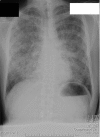Colonization by Pneumocystis jirovecii and its role in disease
- PMID: 22491773
- PMCID: PMC3346301
- DOI: 10.1128/CMR.00013-12
Colonization by Pneumocystis jirovecii and its role in disease
Abstract
Although the incidence of Pneumocystis pneumonia (PCP) has decreased since the introduction of combination antiretroviral therapy, it remains an important cause of disease in both HIV-infected and non-HIV-infected immunosuppressed populations. The epidemiology of PCP has shifted over the course of the HIV epidemic both from changes in HIV and PCP treatment and prevention and from changes in critical care medicine. Although less common in non-HIV-infected immunosuppressed patients, PCP is now more frequently seen due to the increasing numbers of organ transplants and development of novel immunotherapies. New diagnostic and treatment modalities are under investigation. The immune response is critical in preventing this disease but also results in lung damage, and future work may offer potential areas for vaccine development or immunomodulatory therapy. Colonization with Pneumocystis is an area of increasing clinical and research interest and may be important in development of lung diseases such as chronic obstructive pulmonary disease. In this review, we discuss current clinical and research topics in the study of Pneumocystis and highlight areas for future research.
Figures
References
-
- Abouya YL, et al. 1992. Pneumocystis carinii pneumonia. An uncommon cause of death in African patients with acquired immunodeficiency syndrome. Am. Rev. Respir. Dis. 145: 617–620 - PubMed
-
- Afessa B, Green B. 2000. Clinical course, prognostic factors, and outcome prediction for HIV patients in the ICU. The PIP (pulmonary complications, ICU support, and prognostic factors in hospitalized patients with HIV) study. Chest 118: 138–145 - PubMed
-
- Agostini C, Zambello R, Trentin L, Semenzato G. 1995. T lymphocytes with gamma/delta T-cell receptors in patients with AIDS and Pneumocystis carinii pneumonia. AIDS 9: 203–204 - PubMed
-
- Annaloro C, Della Volpe A, Usardi P, Lambertenghi Deliliers G. 2006. Caspofungin treatment of Pneumocystis pneumonia during conditioning for bone marrow transplantation. Eur. J. Clin. Microbiol. Infect. Dis. 25: 52–54 - PubMed
Publication types
MeSH terms
Grants and funding
LinkOut - more resources
Full Text Sources
Medical




